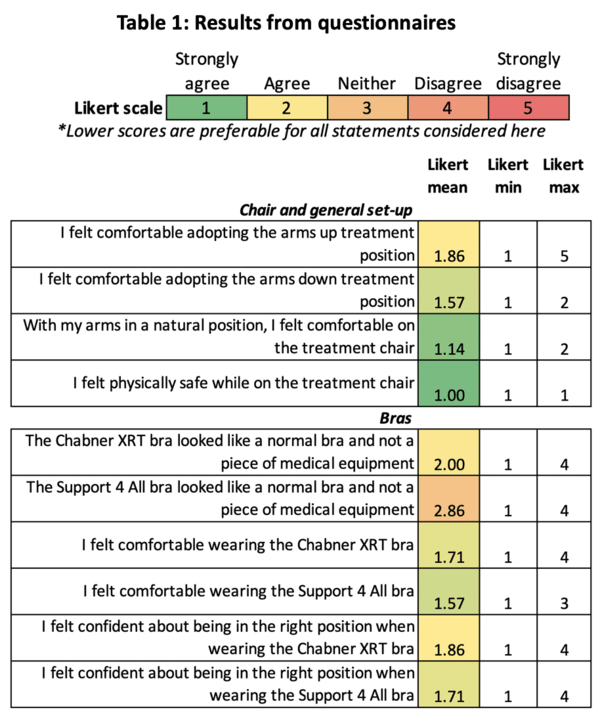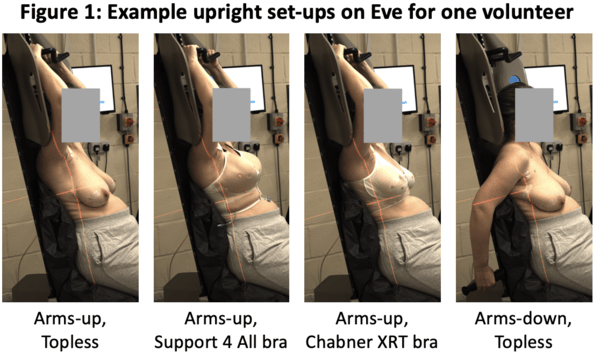A pilot study on upright breast RT: positioning volunteers using a robotic chair & specialised bras
Tracy Underwood,
United Kingdom
PO-2278
Abstract
A pilot study on upright breast RT: positioning volunteers using a robotic chair & specialised bras
Authors: Tracy Underwood1,2, Joanna McNamara3, Jemma Nunn4, Niek Schreuder1, Heidi Probst3
1Leo Cancer Care Ltd, Research, Smallfield, United Kingdom; 2University College London, Department of Medical Physics and Biomedical Engineering, London, United Kingdom; 3University of Sheffield, College of Health, Well-being and Life Sciences, Sheffield, United Kingdom; 4Leo Cancer Care Ltd, Research, Sheffield, United Kingdom
Show Affiliations
Hide Affiliations
Purpose or Objective
Gantry-free, upright RT using fixed treatment beams is attracting interest worldwide as it promises more cost-effective & compact treatment rooms, for all radiation modalities. Here we investigated whether we could position volunteers in a manner appropriate for upright breast RT, using a robotic patient positioning chair: ‘Eve’ from Leo Cancer Care Ltd. As arms-up treatment positions are known to be uncomfortable for many patients who have undergone breast cancer surgery, we investigated both arms-up & arms-down set-ups. In an attempt to reduce inframammary skin folds (ISF) & associated toxicity we tested the Chabner XRT® Radiation Bra (available commercially from CIVCO Radiotherapy™) & the Support 4 All (S4A) bra (under development at Sheffield Hallam University).
Material and Methods
After ethics board review we recruited 7 healthy women, selected to have bra cups>=C (range C:E). A pre-test measurement session was used to determine the volunteers’ nominal bra sizes. On the test day, final fittings & bra selections were performed. Anatomical markers were taped to each woman’s skin to enable estimation of repositioning errors. Perpendicular optical cameras were used to assess these errors (3 repeat tests). A single VacLok bag was moulded for each woman, covering Eve’s seat pan & the lower part of the back-rest. Volunteers were asked to trial: 1) an arms-up position with/without the treatment bras & 2) an arms-down position, topless. The arms-up position was implemented using a Monarch wingboard from CIVCO RT. In total, volunteers spent ~1 hr on Eve, with ~45mins in the arms-up body position. A measuring tape was used to determine upright ISF, with & without the bras. Comfort was assessed using questionnaires & 5-point Likert scales.
Results
With their arms posed naturally, all volunteers reported that the Eve chair felt comfortable & safe. The arms-down position scored slightly higher in terms of comfort: in particular, one participant who had a pre-existing shoulder condition struggled to maintain the arms-up position. Topless breast repositioning errors for the anatomical markers strongly varied from volunteer to volunteer, ranging from ~1:10mm. Both bras were viewed favourably by the volunteers. With no bra, the mean ISF measurement for the 7 women was 4.8cm (range 2.5:9cm). The thicker S4A bra eliminated the ISF for 7/7 women. The thinner Chabner XRT bra eliminated the ISF for 4/7 women; for the other 3, the mean ISF with the Chabner XRT bra was 4.1cm (range 2:6cm). Visibility of the underlying breast was greater for the Chabner XRT bra.


Conclusion
Using Eve, upright set-ups for breast RT are likely to prove comfortable, particularly if arms-down positions are realized. RT bras are effective in reducing/eliminating ISF for upright body positions. Further research must focus on (1) reducing upright set-up errors by further stabilizing the upper body & (2) investigating upright internal anatomy for various arm positions, and the impact of this anatomy on proton/photon treatment plans.